| ← back |
Colonial Meetinghouses Featured in this Project |
next → |
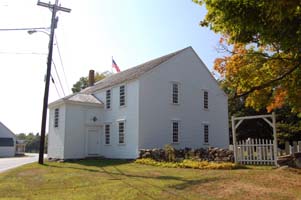 Name of Meetinghouse: Harpswell Meeting House
Name of Meetinghouse: Harpswell Meeting House
View on a mapStreet Address of Meetinghouse: 929 Harpswell Neck Rd. (Rt 123), Harpswell, MEYear(s) Built: 1757 National Register of Historic Places Designation: yes - 1969 Maine State Register of Historic Places: ? Organization responsible: Harpswell Historical Society and the Town of Harpswell Organization's address: 929 Harpswell Rd., Harpswell, ME 04079 Organization's web site: none Town Information: Town of Harpswell, Maine Tax status: Tax Exempt 501(c)(3) Contact: David Hackett, 852 Harpswell Rd., Harpswell, ME 04079 Telephone: (207) 833-6322 E-mail: none This page was last updated on: January 28, 2009 Acknowledgements: The following text has been taken in part from the pamphlet The Story of Harpswell's Old Meeting House, written by Virginia Barnes Woodbury, published by the Harpswell Historical Restoration Committee, and has been used by permission.
Thus Harpswell became a parish in 1751 and employed a minister of its own, the Reverend Richard Pateshall, a Harvard graduate who preached for about three years. In 1753 the Reverend Elisha Eaton was chosen to serve the parish. The need for an adequate meeting house had been apparent for several years when in 1757 plans were drawn up and the Reverend Eaton, perhaps finding local talent unavailable, enlisted his son and namesake to help with the construction. According to his diary, Reverend Eaton made the sashes and frames for the building.
Only the finest carpentry went into the pumpkin pine box pews, for which the original occupants bid as high as $150.00, and also paid a fee each year for their use. The original ten foot high pulpit is on a level with the gallery so that people up there could hear. It's possible that its elevation also gave the preacher a vantage point to check on anyone who might not be as attentive as he should be. Elisha Eaton is buried in the old burying ground immediately behind the Meeting House. The cemetery was in use until about 1900 when it became necessary to refuse further interments because old graves were being uncovered whenever a new grave was opened.
The parish, on March 16, 1842, voted to petition the court to sell or otherwise dispose of the Meeting House. However, there was some confusion as to the legality of the procedure and in September 1842 it was voted to choose a committee of three to remonstrate against the sale. As a result it stood unused for 15 years before it was taken over by the Town of Harpswell. In 1938 the building was included in a Federal program which made detailed drawings of it now on file in the Library of Congress.
On August 20, 1966, in an impressive ceremony, the Maine Chapter of the National Society of Daughters of Founders and Patriots of America placed a bronze marker honoring it as one of the most important historical buildings in the State of Maine. And a final accolade came in 1969 when the Old Meeting House was designated as a National Historic Monument. The Old Meeting House is open to the public every Sunday during the Summer months and is still used occasionally as a place of worship. |
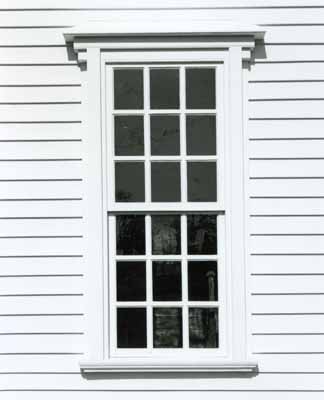
|
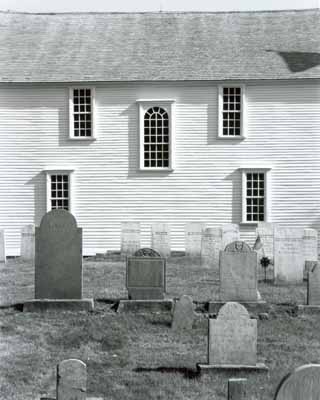
|
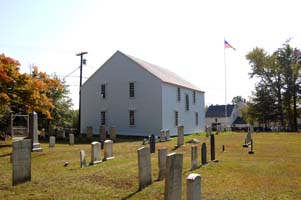 In 1738 the Town of Yarmouth consisted of all the territory between Falmouth and Cape Small Point
including the 99 islands in Casco Bay.
While the early settlers of Harpswell contributed to the support of this preaching for a number of years,
the hardships involved forced them, in 1740, to petition for separation
in order to establish a parish of their own.
In June 1749 the General Court passed an order making Harpswell and the Islands a separate parish.
In 1738 the Town of Yarmouth consisted of all the territory between Falmouth and Cape Small Point
including the 99 islands in Casco Bay.
While the early settlers of Harpswell contributed to the support of this preaching for a number of years,
the hardships involved forced them, in 1740, to petition for separation
in order to establish a parish of their own.
In June 1749 the General Court passed an order making Harpswell and the Islands a separate parish.
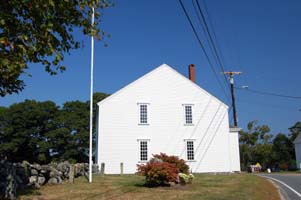 The Meeting House interior was of the utmost simplicity.
The high, dark green, pulpit with its sounding board backed by a multi-paned arched window,
was typical of that period.
Straight backed pews lined the walls.
Later, the original center pews were removed to make room for the administration of town business.
The overhead beams were hand hewn, joined and pegged.
The boards, one and one half inches thick, and the clapboards, were hand made and extra thick to keep out the cold.
In the Deacon's box there is one floor board 29.5 inches wide.
This may have been put there in an effort to flout the law of the King which made it a serious offense
to cut down a tree measuring more than twenty four inches.
(The King had pre-empted all trees over 24 inches in diameter for masts for the British navy.)
The knees used to reinforce the gallery suspension are still to be seen.
The Meeting House interior was of the utmost simplicity.
The high, dark green, pulpit with its sounding board backed by a multi-paned arched window,
was typical of that period.
Straight backed pews lined the walls.
Later, the original center pews were removed to make room for the administration of town business.
The overhead beams were hand hewn, joined and pegged.
The boards, one and one half inches thick, and the clapboards, were hand made and extra thick to keep out the cold.
In the Deacon's box there is one floor board 29.5 inches wide.
This may have been put there in an effort to flout the law of the King which made it a serious offense
to cut down a tree measuring more than twenty four inches.
(The King had pre-empted all trees over 24 inches in diameter for masts for the British navy.)
The knees used to reinforce the gallery suspension are still to be seen.
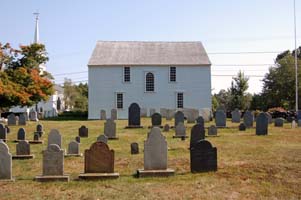 When Elijah Kellogg was asked to become the settled pastor of Harpswell,
he asked for a larger church.
After considerable controversy between denominational groups,
some of whom refused to pay taxes for the support of a Congregational minister,
enough supporters were finally enlisted to form an entirely new society and the building
of a new church across from the Meeting House was undertaken.
This church, known as the Kellogg Church, is still an active entity and regular services are held there every Sunday.
When Elijah Kellogg was asked to become the settled pastor of Harpswell,
he asked for a larger church.
After considerable controversy between denominational groups,
some of whom refused to pay taxes for the support of a Congregational minister,
enough supporters were finally enlisted to form an entirely new society and the building
of a new church across from the Meeting House was undertaken.
This church, known as the Kellogg Church, is still an active entity and regular services are held there every Sunday.
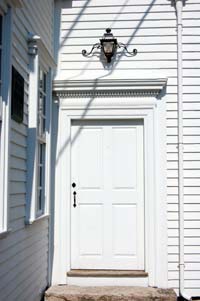 In 1958 Harpswell celebrated its bi-centennial.
When the bills for the celebration were paid it was found that there was a profit of $1,400.00.
After much discussion, it was decided to use the money to begin the restoration of the Meeting House.
John Alien of Harpswell, a master cabinet maker and a descendant of one of the families
who worshipped in the Meeting House, has done much of the work himself.
Window frames have been especially milled and the 7x9 panes of glass were obtained from the same firm
that supplies Williamsburg.
The off-white plaster that has been done matches exactly the original clam shell plaster.
While repairing the plaster, a keg of bullets, believed to have been for use in the War of 1812, was found in the blind attic.
In 1958 Harpswell celebrated its bi-centennial.
When the bills for the celebration were paid it was found that there was a profit of $1,400.00.
After much discussion, it was decided to use the money to begin the restoration of the Meeting House.
John Alien of Harpswell, a master cabinet maker and a descendant of one of the families
who worshipped in the Meeting House, has done much of the work himself.
Window frames have been especially milled and the 7x9 panes of glass were obtained from the same firm
that supplies Williamsburg.
The off-white plaster that has been done matches exactly the original clam shell plaster.
While repairing the plaster, a keg of bullets, believed to have been for use in the War of 1812, was found in the blind attic.